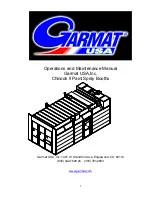
Compact Operating Instructions in accordance with EN 61010-1 and EN 60079-0
A5E45779389002-01, 09/2018
17
WARNING
Improper power supply
Risk of explosion in hazardous areas as result of incorrect power supply, e.g. using direct current instead of alternating
current.
•
Connect the device in accordance with the specified power supply and signal circuits. The relevant specifications can
be found in the certificates, in Laws and directives (Page 16) or on the nameplate.
WARNING
Improper laying of shielded cables
Risk of explosion through compensating currents between hazardous area and the non-hazardous area.
•
Shielded cables that cross into hazardous areas should be grounded only at one end.
•
If grounding is required at both ends, use an equipotential bonding conductor.
WARNING
Lack of equipotential bonding
Risk of explosion through compensating currents or ignition currents through lack of equipotential bonding.
•
Ensure that the device is potentially equalized.
Exception: It may be permissible to omit connection of the equipotential bonding for devices with type of protection
"Intrinsic safety Ex i".
WARNING
Unsuitable cables, cable glands and/or plugs
Risk of explosion in hazardous areas.
•
Use only cable glands/plugs that comply with the requirements for the relevant type of protection.
•
Tighten the cable glands in accordance with the torques specified in Technical specifications (Page 37).
•
Close unused cable inlets for the electrical connections.
•
When replacing cable glands, only use cable glands of the same type.
•
After installation, check that the cables are seated firmly.
WARNING
Incorrect choice of explosion protection type
Danger of explosion in hazardous areas.
If this device is approved for various types of protection:
1.
Choose one type of protection.
2.
Connect the device according to this type of protection.
3.
To prevent improper use at a later time, conceal the other protection types on the label that are not being used on a
sustained basis.
WARNING
Unsuitable devices
Only devices which do not generate sparks during operation may be connected to non-energy-limited circuits in Zone 2 or
22, and these must be suitable for operation in hazardous areas of Zone 2 or 22 and the conditions present at the location
of use.
















































